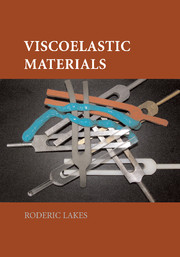Book contents
- Frontmatter
- Contents
- Preface
- 1 Introduction: Phenomena
- 2 Constitutive Relations
- 3 Dynamic Behavior
- 4 Conceptual Structure of Linear Viscoelasticity
- 5 Viscoelastic Stress and Deformation Analysis
- 6 Experimental Methods
- 7 Viscoelastic Properties of Materials
- 8 Causal Mechanisms
- 9 Viscoelastic Composite Materials
- 10 Applications and Case Studies
- A Appendix
- B Symbols
- Index
2 - Constitutive Relations
Published online by Cambridge University Press: 21 January 2010
- Frontmatter
- Contents
- Preface
- 1 Introduction: Phenomena
- 2 Constitutive Relations
- 3 Dynamic Behavior
- 4 Conceptual Structure of Linear Viscoelasticity
- 5 Viscoelastic Stress and Deformation Analysis
- 6 Experimental Methods
- 7 Viscoelastic Properties of Materials
- 8 Causal Mechanisms
- 9 Viscoelastic Composite Materials
- 10 Applications and Case Studies
- A Appendix
- B Symbols
- Index
Summary
Introduction
For some applications of viscoelastic materials, it is sufficient to understand creep and relaxation properties. For example sometimes structural elements are maintained under steady load or constant extension. In other applications the response to an arbitrary load or strain history is required. To predict this response, constitutive equations that incorporate all possible responses are of use. Various mathematical tools are used in the development of these equations. The viscoelastic functions in the equations are obtained by experimentation.
Prediction of the Response of Linearly Viscoelastic Materials
Prediction of Recovery from Relaxation E(t)
The creep and relaxation properties described above in §1.3 permit one to predict the response of the material to a step function stress or strain. To predict the response of the material to any history of stress or strain (i.e., stress or strain as a function of time), constitutive equations are developed.
The following is restricted to isothermal deformation in one dimension. The symbol E is used to represent an elastic modulus, however, the analysis applies equally to shear deformation corresponding to a shear modulus G or volumetric deformation corresponding to a bulk modulus B, which is sometimes called K.
To develop the constitutive equation for linear materials, we use the Boltzmann superposition principle, which states that the effect of a compound cause is the sum of the effects of the individual causes. This principle is a statement of linearity. First, we consider the strain associated with a relaxation and recovery experiment, with the intention to use the idea of linearity as embodied in the Boltzmann superposition principle to predict the resulting stress history.
- Type
- Chapter
- Information
- Viscoelastic Materials , pp. 14 - 54Publisher: Cambridge University PressPrint publication year: 2009
- 2
- Cited by



